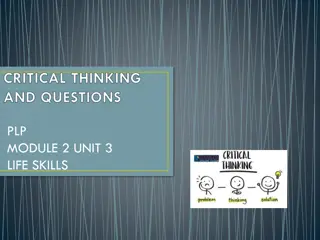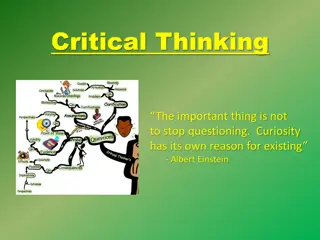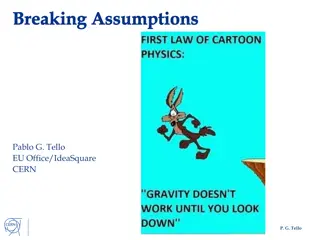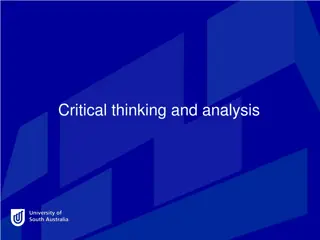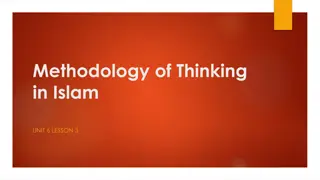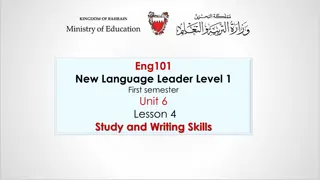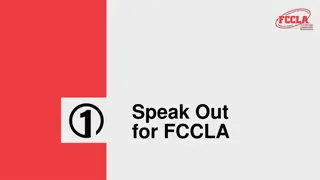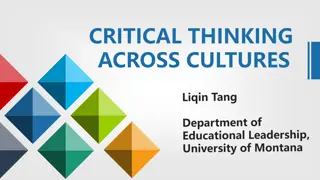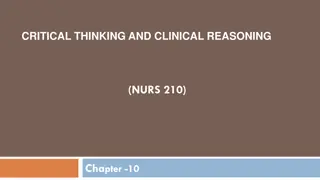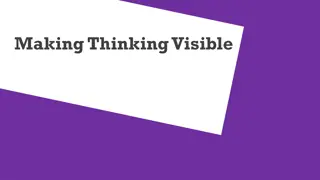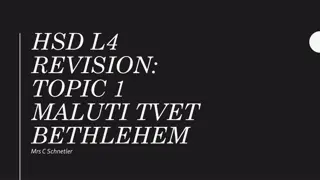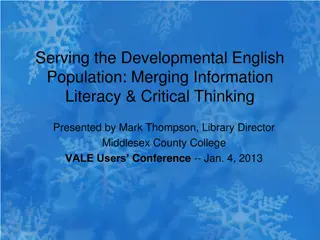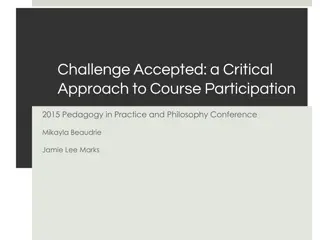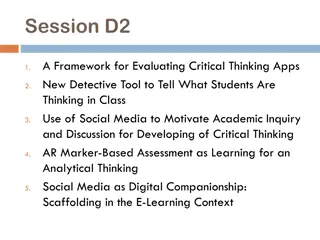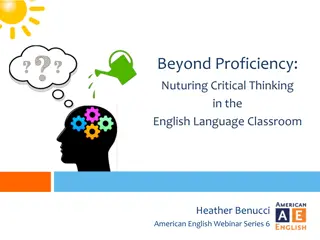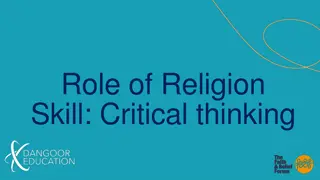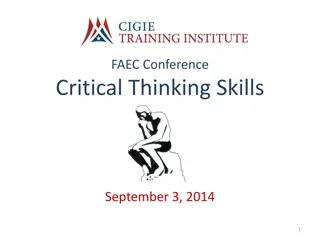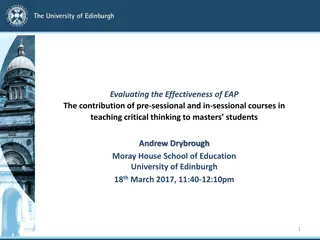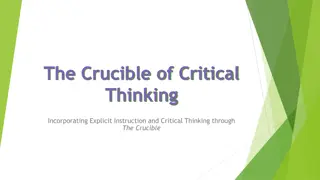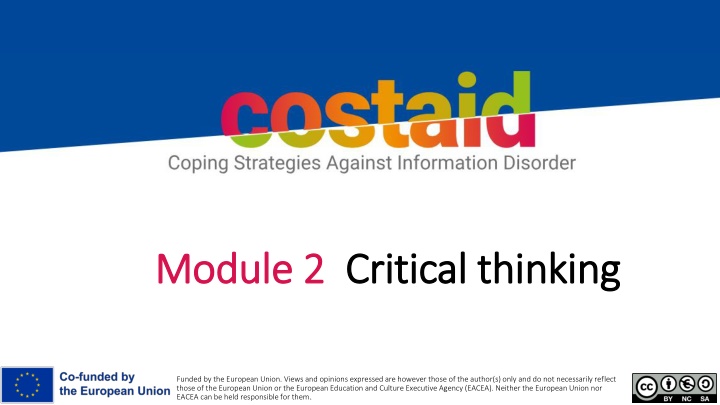
Importance of Critical Thinking in Education and Information Processing
Explore the significance of critical thinking in dealing with information disorder, learn about its components and tools, and understand its roots in philosophy, psychology, and education. Discover the key dispositions and abilities needed for effective critical thinking, emphasizing the importance of background knowledge in various domains.
Download Presentation

Please find below an Image/Link to download the presentation.
The content on the website is provided AS IS for your information and personal use only. It may not be sold, licensed, or shared on other websites without obtaining consent from the author. If you encounter any issues during the download, it is possible that the publisher has removed the file from their server.
You are allowed to download the files provided on this website for personal or commercial use, subject to the condition that they are used lawfully. All files are the property of their respective owners.
The content on the website is provided AS IS for your information and personal use only. It may not be sold, licensed, or shared on other websites without obtaining consent from the author.
E N D
Presentation Transcript
https://www. https://www.costaid costaid.eu .eu Module Module 2 2 C Critical ritical thinking thinking Funded by the European Union. Views and opinions expressed are however those of the author(s) only and do not necessarily reflect those of the European Union or the European Education and Culture Executive Agency (EACEA). Neither the European Union nor EACEA can be held responsible for them.
Modules 4. Enabling dialogue 1. Awareness 5. Ethics 2. Critical thinking 6. Reflective skills 3. Conflict solving 7. Digital skills
Critical thinking 2 Objectives To demonstrate how critical thinking is important for dealing with information disorder To explain what critical thinking is and what its components are To illustrate the tools that both individuals and educators can use for critical thinking and that help build critical thinking skills
Critical thinking 2 What is critical thinking? Critical thinking is a concept that has its roots in three academic disciplines: philosophy, (cognitive) psychology, and education. 1. The philosophical approach focuses on the hypothetical critical thinker, and on the qualities and characteristics of this person as an ideal type rather than the behaviors or actions the critical thinker can perform. 2. The psychological approach focuses on how people actually think versus how they ideally should think. Critical thinking here is defined by actions or behaviors that critical thinkers can perform. 3. The educational approach is based on observations of student learning and views critical thinking within a hierarchical taxonomy of cognitive information processing skills, with comprehension at the bottom and evaluation at the top, and the three top levels (analysis, synthesis, evaluation) representing critical thinking. Source | Image source
Critical thinking 2 Components of critical thinking 2. Dispositions (attitudes, habits of mind) 1. Abilities (skills) Open-mindedness Analysis of arguments, claims, and evidence Fairness Making inferences using inductive or deductive reasoning Propensity to seek reason Curiosity Judging or evaluating information Desire to be well-informed Making decisions and solving problems Flexibility Empathy 3. Importance of background knowledge Domain-specific knowledge is crucial, as evaluations and evidence vary highly from one domain to another Too much value is lost if critical thinking is seen as simply a list of logical operations Source | Image source
Critical thinking 2 Critical thinking for dealing with information disorder Critical thinking for dealing with information disorder concerns the ability to question information that individuals see, and the ability to distinguish between high-quality and unreliable content Research indicates that, on the whole, students often lack the necessary skills to effectively navigate information disorder. To address this issue, it is crucial to provide education on information disorder and to promote initiatives that stimulate critical thinking among students. These measures are vital for enabling students to construct their own internal cognitive firewall that can safeguard them against the perils of information disorder. Source
Critical thinking 2 A multiliteracies framework The rapid changes around information disorder in the digital age require a wide array of knowledge and skills in order for individuals to be able to deal with information disorder in an effective way. The multiliteracies framework contains skills for dealing with information disorder combined with knowledge about factors that contribute to information disorder. This allows for a dynamic framework of skills and knowledge that can be expanded upon as the landscape of information disorder shifts and changes in the future. Key components include: (Critical) media literacy Information literacy News literacy Algorithmic literacy Statistical/quantitative literacy/numeracy Knowledge of power and implications of artificial intelligence Source
Critical thinking 2 Thinking, fast and slow When presented a piece of information, individuals can engage in one of two ways of information processing: systematic processing or heuristic processing. 1. Systematic processing encompasses careful, thorough analysis of the evidence that is present to arrive at a well-founded credibility evaluation. Systematic evaluations require substantial mental effort. 2. Heuristic processing is characterised by a rather intuitive use of heuristics or rules-of- thumb that require little to no cognitive effort, to arrive at a quick credibility judgment. Critical thinking concerns taking the time to engage in more detailed and specific processing when confronted with news or information, by considering the time needed to reflect on the source of the information, its reliability and credibility, its biases, the possible agenda that underlies it. Source 1 | Source 2 | Source 3 Image source
Critical thinking 2 Sceptical knowing In their work, journalists and fact-checkers engage in systematic processing and evaluations of information using the following six questions, which make up the principle of sceptical knowing . 1. Type: What kind of content is this? 2. Source: Who and what are the sources cited and why should I believe them? 3. Evidence: What is the evidence and how was it vetted? 4. Interpretation: Is the main point of the piece proven by the evidence? 5. Completeness: What is missing? What might be an alternative explanation or understanding? 6. Knowledge: Am I learning every day what I need? Source | Image source
Critical thinking 2 Critical ignoring The complex digital environment containing constant stimuli competing for our attention make it difficult, if not impossible, to use these six questions with each piece of information we encounter. Instead of promoting critical thinking about any piece of information, it is important that we know which information we can invest our limited cognitive/attentional capacities in, and which information is better to ignore in order to not deplete our mental resources. This balance between knowing what to ignore online and where to invest time and effort is known as critical ignoring . Critical ignoring constitutes a paradigm shift for educators from focusing on analysing information to the power of ignoring information. Critical ignoring is seen as a new critical thinking for the digital age. Source 1 | Source 2
Critical thinking 2 Three tools for critical thinking 1. Self-nudging involves the use of situational control strategies to effectively handle exposure to distracting and hard-to-resist stimuli. This strategy conserves the autonomy and agency of users, and helps in regaining control over their information environment. For example, setting time limits on social media, setting screen in grayscale. 2. Lateral reading concerns checking information by leaving the source and verifying the information using a different source elsewhere. For example, checking multiple news sites about the same reported event. 3. Do not feed the trolls -heuristic concerns being aware of not engaging with and rewarding malicious online actors with attention. For example, by blocking and reporting them Source 1 | Source 2 | Image source
Critical thinking 2 Building critical thinking while avoiding scepticism, cynicism, and distrust While teaching critical thinking about information to students, it is important to pay attention to not stimulate exaggerated scepticism, cynicism, and distrust of media. There is a fine line between healthy scepticism and distrust: despite its good intentions, media literacy education could teach students to distrust online information without equipping them with the necessary skills to determine themselves whether a piece of online information is credible. This evolution might result in a general distrust of the media and bad credibility evaluation methods that encompass selective research that only reaffirms pre-existing beliefs.
Critical thinking 2 Awareness of cognitive biases To avoid exaggerated scepticism, it is important that educators teaching critical thinking about online information not only focus on the media, but also on individuals own potential fault lines or cognitive biases. This encompasses teaching how people s fundamental beliefs have an impact on the way that they relate to information and news; and what might be done to help them become more judicious in their approach to information. An example of cognitive bias is confirmation bias, which occurs when individuals have the tendency to gravitate towards information that confirms their pre-existing worldview, rather than information that deviates from it. Research shows that misinformed people do not change their minds once they have been presented with facts that challenge their beliefs; rather they are likely to become more attached to their mistaken beliefs. Source 1 | Source 2 | Image source
Critical thinking 2 The power of curiosity for critical thinking To prevent confirmation bias and foster openness to diverse worldviews that challenge their existing beliefs, simply lecturing people and telling them they are wrong is an ineffective and possibly counterproductive approach. Instead, researchers believe that stimulating individuals curiosity and finding effective ways of triggering a spirit of enquiry in the education system and beyond might be the key to stimulating critical thinking, as curiosity has been shown to counteract biased information and to promote open-mindedness. Educators are advised to devise teaching and learning approaches which enable students to be genuinely curious about the world, in such a way that they are able to make judgements about information and accept evidence that contradicts their beliefs and not simply look for information that confirms them. Source
Critical thinking 2 Strategies for teaching critical thinking Researchers recommend four types of instruction for teaching critical thinking 1. Explicit instruction about critical thinking, also taking into account the dispositional/affective component of critical thinking. 2. Collaborative or cooperative learning, where social interactions and relationships are important for developing critical thinking skills. Collaborations create opportunities for disagreements and misconceptions to surface and be corrected. Provide students with common background knowledge in which to collaborate Provide groups with questions or analytical frameworks that are a bot more sophisticated than they would tend to use on their own Structure activities by assigning specific student roles and by creating incentives Source | Image source
Critical thinking 2 Strategies for teaching critical thinking 3. Modeling, where teachers model critical thinking in their own instruction by making reasoning visible/clear to students Use thinking aloud , so students can observe teacher using evidence and logic to support arguments and assertions Use concrete examples that are relevant for teaching abstract concepts such as conflicts of interest 4. Constructivist techniques, where students take the lead in their own learning and the role of the teacher is de-emphasised. Source
Critical thinking 2 References and further reading Damasceno, C. S. (2021). Multiliteracies for combating information disorder and fostering civic dialogue. Social Media +. https://doi.org/10.1177/2056305120984444 Goldstein, S., Secker, J., Coonan, E., & Walton, G. (2017). Written evidence submitted by InformAll and the CILIP Information Literacy Group (FNW0079). Retrieved from: https://data.parliament.uk/writtenevidence/committeeevidence.svc/evidencedocument/culture-media-and-sport- %20committee/fake-news/written/48215.html Jones, D. (2016). Seeing reason. Human brains skew facts. How can we change our minds? New Scientist, 232 (3102), pp.28-32. Kahneman, D. (2011). Thinking, fast and slow. London: Penguin Kozyreva, A., Wineburg, S., Lewandowsky, S., & Hertwig, R. (2023). Critical ignoring as a core competence for digital citizens. Current Directions in Psychological Science, 32(1), 81 88. https://doi.org/10.1177/09637214221121570 Lai, E. R. (2011). Critical thinking: A literature review. Pearson s Research Reports, 6(1). Lewandowsky, S., Ecker, U. K. H., Seifert, C. M., Schwarz, N., & Cook, J. (2012). Misinformation and its correction: Continued influence and successful debiasing. Psychological Science in the Public Interest, 13(3), 106 131. https://doi.org/10.1177/1529100612451018 Metzger, M. J. (2007). Making sense of credibility on the Web: Models for evaluating online information and recommendations for future research. Journal of the American Society for Information Science and Technology, 58(13), 2078 2091. https://doi.org/10.1002/asi.20672 Rosenstiel, T. (2013). Six questions that will tell you what media to trust. American Press Institute. Retrieved from: https://americanpressinstitute.org/publications/six-critical-questions-can-use-evaluate-media-content/
Critical thinking 2 References and further reading Stanford History Education Group, (Nov. 22, 2016) Evaluation Information: The Cornerstone of Civic Online Reasoning. https://sheg.stanford.edu/upload/V3LessonPlans/Executive%20Summary%2011.21.16.pdf Sundar, S. S. (2008). The MAIN model: A heuristic approach to understanding technology effects on credibility. In M. Metzger & A. J. Flanagin (Eds.), Digital media, youth, and credibility (pp. 73 100). Cambridge, MA: The MIT Press. https://doi.org/10.1162/dmal.9780262562324.073 Trevors et al. (2017). Exploring the relations between epistemic beliefs, emotions, and learning from texts. Contemporary Educational Psychology, 48, 116 132. Wardle, C., & Derakhshan, H. (2017). Information disorder: Toward an interdisciplinary framework for research and policy making. Strasbourg. Retrieved from: https://edoc.coe.int/en/media/7495-information-disorder-toward-an-interdisciplinary-framework-for-research-and-policy- making.html White, A. (2022). Overcoming confirmation bias and the persistence of conspiratorial types of thinking. Continuum: Journal of Media & Cultural Studies, 36(3), 364 376. https://doi.org/10.1080/10304312.2021.1992352 World Economic Forum (2023). Critical thinking is great, but in a world full of information we need to learn 'critical ignoring . Retrieved from: https://www.weforum.org/agenda/2023/02/critical-thinking-ignoring-brain/
Critical thinking 2 Congratulations! Congratulations! You have completed this part You have completed this part Funded by the European Union. Views and opinions expressed are however those of the author(s) only and do not necessarily reflect those of the European Union or the European Education and Culture Executive Agency (EACEA). Neither the European Union nor EACEA can be held responsible for them.

